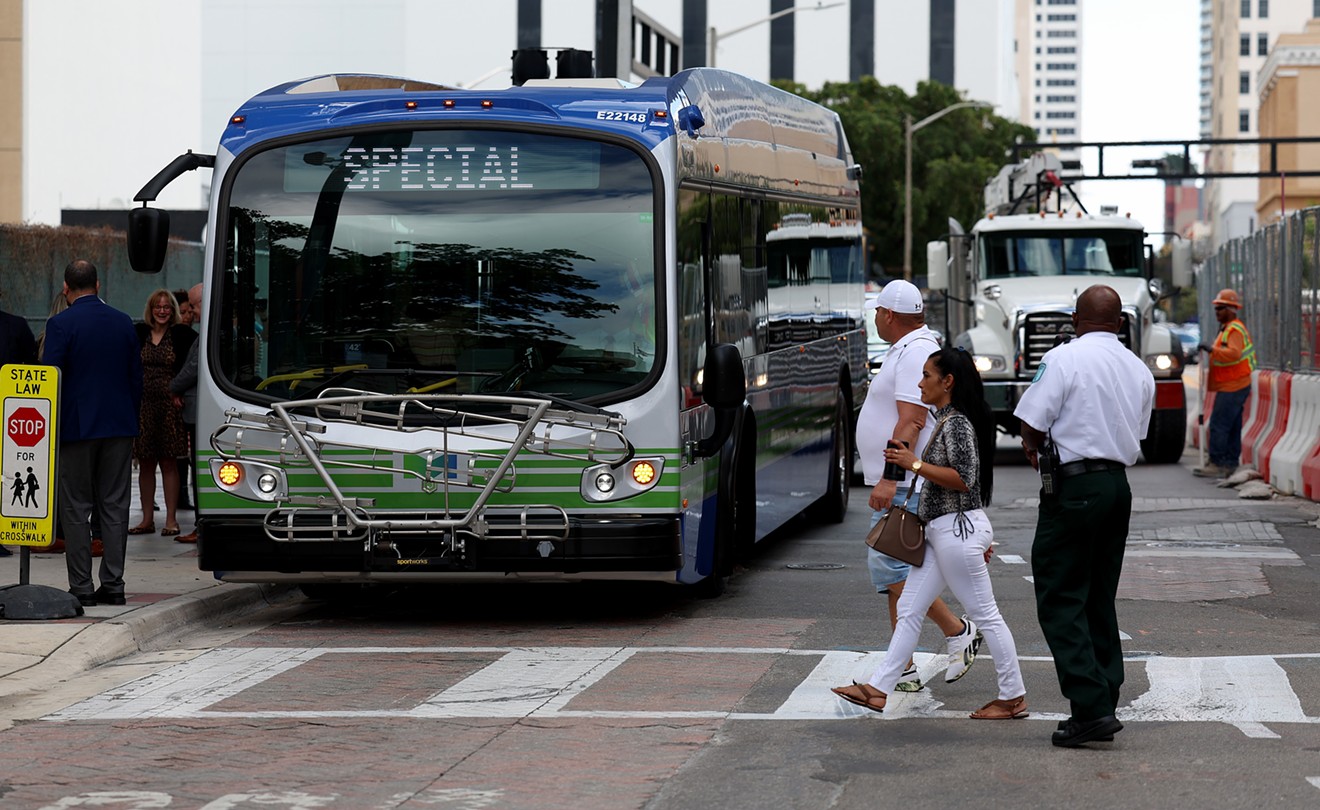Four years in the making, the Better Bus Network is an attempt to modernize a bus system that serves some 180,000 riders a day. The new network discontinued and shortened dozens of routes in favor of revving up bus activity at popular destinations, in what the county describes as the first major redesign of the system "since the start of Metrorail in 1986."
While Miami-Dade County pledged the changes would streamline the network and reduce wait times at busy locations, opponents say the overhaul is already making riders' daily transit more difficult and forcing some of them, including elderly riders, to walk longer distances to reach their bus stops.
The new route network went into effect on November 13, increasing high-frequency routes from five to 19. The county says that under the new system, the percentage of residents who live near high-frequency routes will grow from 14 to 30 percent.
"This is 800,000 people that can basically leave their house and go for a five- or ten-minute walk to a bus stop and catch a bus that arrives every 15 minutes or sooner," says District 5 County Commissioner Eileen Higgins, who uses county buses to travel to Miami Beach and Trader Joe’s in Midtown.
The elimination of longstanding bus lines around town has sparked vocal backlash, however, including from Jose Peres, a former Miami-Dade transit employee who worked for the county for more than 30 years.
"You are taking away from the needy to try to attract new riders," Peres tells New Times. "It’s not a service expansion. It’s a service reduction."
Peres and others who oppose the program have detailed their concerns on the Miami Bus Riders Against the Better Bus Network page on Facebook. The group documented the first day of the rollout and the frustration and confusion that came along with it as riders dealt with the axing of routes they've taken for years. Anecdotes of peeved passengers yelling at transit ambassadors and bus operators were aplenty, with one report of a rider throwing a Better Bus pamphlet at a driver. One user proclaimed it was "absolute chaos" on the 2 line.
Peres says the redesigned bus network is upending transit for countless riders.
For starters, he points to the 32 bus line that served working-class residents with stops at Miami Dade College’s North campus and the Opa-locka library. The 32 south now stops at 36th Street, and riders headed to the Civic Center have to transfer to the new 20 bus line, according to Peres.
"The 20 stays on 20th Street, so those who want to go to hospitals in the health district will have to walk a few blocks," Peres says. "If you’re in a wheelchair, you’re gonna have to roll."
In Miami’s southwest region, Peres says, the eponymous 104 route, with stops at Miami Dade College’s Kendall campus, no longer makes stops at the Federation Gardens senior complex or Killian High School.
"You’re taking it from the elderly and from the students and going to put it on 107th Avenue," Peres says.
Higgins maintains the Better Bus plan simplifies what was previously a labyrinthine route network that looked like spaghetti on the county map. She says the changes were meant to iron out inefficiencies in the system, which sees more than 700 buses chugging through the county each day.
"The main goal is to provide better bus service for residents," says Higgins, who sponsored the program. "We have improved frequency and added more high-frequency routes with better weekend service."

Miami-Dade County is banking on MetroConnect van service to fill transit gaps after the implementation of the Better Bus network.
Miami-Dade Better Bus map
County Bets on MetroConnect
Miami-Dade's Department of Transportation and Public Works says its MetroConnect minivans will close the gaps on canceled or shortened routes. The rebranded, free service, formerly known as GO Connect, meets riders wherever they are as long as they're within a service zone. The sporty green-and-blue vans serve ten clusters around the county, including Civic Center, Westchester, north and south Kendall, north and south Dadeland, South Dade, Cutler Bay, and an area north of Goulds called "Transit Way." Some of the vehicles are wheelchair accessible.
"With a few taps on the MetroConnect app, you can book a ride to be paired with others headed your way," the department says.
Communities like Medley, Miami Springs, Hialeah, Opa-locka, and North Miami are outside the MetroConnect zones.
Of those five cities, only North Miami replied to New Times' request for comment.
North Miami Councilman Scott Galvin tells New Times that his city's free trolley could fill the service gaps left by route changes and the absence of MetroConnect in North Miami. City Manager Rasha Cameau says county officials were scheduled to meet with city staff on November 9 to discuss the overhaul and that the city will be co-hosting a community meeting with the county on November 15.
North Miami and more than 30 other cities receive funds from the Citizens' Independent Transportation Trust, which finances local shuttles and circulator bus services. Created in 2002, the trust collects a half-penny sales tax and disburses 20 percent of the proceeds to municipalities on "a pro-rata basis for use on local transportation," according to the county.
This early in the Better Bus Network rollout, it's unclear the extent to which locations with MetroConnect service voids will adjust their trolleys and shuttles to accommodate those affected by discontinued bus routes.
The Better Bus overhaul arrives after a year-over-year spike in ridership, according to county records. In September, Miami-Dade recorded more than 4.5 million riders, a 44 percent increase over September 2022.
Modernizing or Oversimplifying?
Miami-Dade started the bus network redesign process in 2019 after a period of decreased ridership that coincided with lower gas prices. From 2013 to 2017, Metrobus ridership declined from about 79 million annual riders to roughly 58 million in 2017, the county noted in its 2019 Transit Choices report."The more recent declines in ridership suggest that the big expansions and contractions in service over the last 20 years may have left Miami-Dade Transit with a network that does not work well for the communities it serves," the report said.
In October 2021, a measure was approved by the Board of County Commissioners to advance the Better Bus project. The county has since promised the changes will ensure "all-day, high-frequency service in dense minority and low-income areas, high frequency on all causeways, and bus stop consolidation to help speed up service."
The county claims it factored in survey results and input from public hearings in devising the new route map. But critics of the new routes have been sounding off in recent weeks, saying that the wide-sweeping service shifts were hardly aligned with residents' needs.
"All hell is going to break loose," David Kupferman, of North Miami Beach, wrote in a letter to the editor in Wednesday’s Miami Herald. "It hath no fury like a passenger whose bus route was discontinued."
Such fury may grow.
The county has a five-page list of bus routes that have been changed, shortened, discontinued, extended, or added. Meanwhile, thousands of bus stops in the county were plastered with yellow "service change" advisories in English, Spanish, and Creole that explained changes for each location in the time leading up to the big switch. (A full map of the new routes is attached at the end of the article, along with the description of route changes.)
Over in Miami Beach, the S route that had traveled from the Omni to Aventura Mall was discontinued as of Nov. 13. Even with the North Beach loop, South Beach loop, Middle Beach loop, and Collins Express, which altogether tallied nearly 11 million riders from 2016 to 2018, some gaps remain.
The 241 Tuttle Limited bus line between Miami and Mount Sinai Medical Center is now discontinued, with the county directing riders to bus lines 14 and 36.
In the county's northwest region, Peres says, the 36 line will no longer serve the Dolphin Mall, Ikea, or Miami Dade College’s West Campus, leaving college students and workers in a jam. The 36 will also cease operations in Virginia Gardens and Miami Springs, where it serviced the business district, parks, post office, police station, and city hall, according to Peres.
The county suggests that high school students and others who relied on the 36 route either walk 1.5 miles to 3rd and Palm in Hialeah or wait for the "Miami Springs/Virginia Gardens Free-Bee shuttle," a Citizens' Independent Transportation Trust-funded service.
Faring Well?
To relieve the stress on residents and give riders a chance to preview the new network, the county is waving Metrobus fares from November 13 through December 31.The generosity cost Department of Transportation and Public Works Director Eulois Cleckley a two-week suspension, as Miami-Dade County's mayor cited him for allegedly failing to properly obtain approval from the county for the free fare program.
"I support a community-focused approach to utilize our public transit system fare-free for the holiday season; however, the proper processes were not followed in the rollout of this plan," Mayor Daniella Levine Cava wrote in a memo to the county board of commissioners.
The county is projecting it will miss out on $9 million in fares during the free-ridership period.
"There was already a budget allocation for the implementation of the historic Better Bus Network of some $6 million, which is largely intact," Juan Mendieta, public affairs officer at the Department of Transportation and Public Works, tells New Times.
Higgins tells New Times the county plans to make up any losses through a rise in new ridership.
"First week, people may be nervous and confused learning the new routes, and we don’t need them struggling with their metro cards and their fares, too," says Higgins. "Let them feel comfortable and get them moving."











